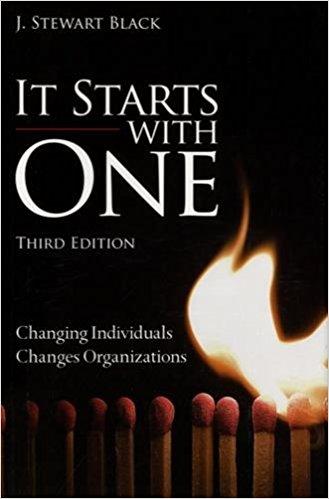It Starts With One Summary
5 min read ⌚
 Changing Individuals Changes Organizations
Changing Individuals Changes Organizations
You know that ancient saying: “Nothing is permanent except change.” The same is still true, especially for organizations operating in today’s turbulent markets.
Read our summary and learn how you can implement change in your organization the right way.
Who Should Read “It Starts With One”? And Why?
We all know that organizations need to change, but still, managers seem to go about it the wrong way.
What they usually do is they order some organizational shifts, believing that their employees will just accept them, and so the transformation will proceed smoothly with not much effort.
However, usually, that is not the case. People resist change, and the organization needs to work hard to make changes permanent and accepted.
Authors J. Stewart Black and Hal B. Gregersen explain how a company can fight the resistance to change, and how can it finally alter the status quo.
We recommend “It Starts With One” to all managers, executives and business owners who want to inspire and motivate their employees to want to change, and thus be able to control the way the transformation happens.
About J. Stewart Black and Hal B. Gregersen
 Stewart Black teaches at INSEAD, Europe’s largest M.B.A. organization.
Stewart Black teaches at INSEAD, Europe’s largest M.B.A. organization.
 Hal Gregersen, apart from being a co-author of nine other books and a teacher at INSEAD as well, was a Fulbright Fellow at the Turku School of Economics.
Hal Gregersen, apart from being a co-author of nine other books and a teacher at INSEAD as well, was a Fulbright Fellow at the Turku School of Economics.
“It Starts With One Summary”
We have said it countless times so far, and we will repeat it: if your company doesn’t evolve, it will not survive.
However, although change is a business issue that everyone talks about, most of the “experts” in change discuss in the wrong way.
In other words, most business and management books consider change as an organizational phenomenon, a matter of command and control.
They give you a checklist of things you need to do, and voila – you have a renewed organization.
Sorry to break it to you, but it is not that easy.
Change is a personal phenomenon. And people are complicated. To make them alter their actions and behaviors, you need to try hard and invest a lot of effort, time and money.
This does not mean that your implementation processes should be complicated.
On the contrary, many programs fail just because of such complexities. Do the opposite: keep your processes as simple as possible.
Avoid multitasking and working on changing many aspects at once.
Focus on the most crucial factors you want to alter and do it first, before moving on to the next ones. Setting realistic goals will make you feel motivated longer, and will produce better results.
Of course, it will not go as smoothly as you would want it to go.
People will resist your attempts since they avoid unfamiliar situations. Each of us has a mental map engraved in our brain which guides all our actions.
These maps often create barriers that make change deeply difficult.
Every barrier consists of three components.
First, the failure to see. To tear down this barrier you need to employ “contrast and confrontation.” Contrast is seeing things in comparison among themselves. Then, make people confront information using all of their five senses.
The second component is the failure to move. This barrier explains why even when people know that they need to progress in some way, they still stay the same, in their familiar comfort zones.
What you need to do to break this barrier is to persuade your employees that you will help them to develop beyond being novices in the new situation, and reach their former competence.
You can go about this process in three steps, which we list in the key lessons below.
The third component is the failure to finish. Do not suppose that just because your employees have understood the need to progress and took a few steps, they will end the “race.”
Many times people start but never finish, and let their skepticism win and take them back to where they started in the first place.
To avoid employees falling off track, appoint change champions to inspire people and assure them that their efforts matter.
Also, you can create a progress chart, so people can check how they are doing and how far they have come.
“Key Lessons from “It Starts With One”
1. The Four Stages of “Fundamentals of Change”
2. Instilling “Contrast and Confrontation”
3. Areas for Assessing Priorities with the “ARCTIC Framework of Individual Analysis”
The Four Stages of “Fundamentals of Change”
-
- The old methods work great, and people use them skillfully.
-
- Even though the old procedures were the right tactics in the past, they will not work so well in the future. Over time, they have become the wrong way to do things.
-
- Start using new behaviors and methods. At first, you will carry them out poorly, and that will make you want to return to the old ways.
- When you stick with the new approaches, sooner or later you will begin to do things well again – but in an innovative way.
Instilling “Contrast and Confrontation”
-
- “Destination”: Set a clear, concrete goal, and teach your employees targeted attitudes.
-
- “Resources”: Teach your workers new skills and methods, which they can use to improve the work.
- “Rewards”: Give your employees incentives. Picking the right incentives depends on how well you know your employees.
Areas for Assessing Priorities with the “ARCTIC Framework of Individual Analysis”
-
- “Achievement” – The need to do well.
-
- “Relations” – The need to be a part of a group, all the while being recognized as unique.
-
- “Conceptual/Thinking” – The need to find solutions to problems.
-
- “Improvement” – The need to grow personally and to learn and try new skills.
- “Control” – The need to feel that you have some influence and are in control of things.
Like this summary? We’d Like to invite you to download our free 12 min app, for more amazing summaries and audiobooks.
“It Starts With One” Quotes
Companies tend to err in the direction of sharing change progress with too few people. Share on X Change efforts fail to finish because people get tired. They get tired in an absolute sense because change requires energy and effort. Share on X Change champions are needed exactly where the rubber meets the road. Share on X Change is extraordinarily difficult, and most attempts to initiate and sustain it fail. Share on X Leaders must confront their people and sometimes themselves with key contrasts between the past, present and future versions of the world. Share on XOur Critical Review
“It Starts With One” is not a quick and easy concept that will bring you overnight results. Instead, it is a logical and methodical approach that will ensure lasting changes.
Emir is the Head of Marketing at 12min. In his spare time, he loves to meditate and play soccer.


 Changing Individuals Changes
Changing Individuals Changes 




